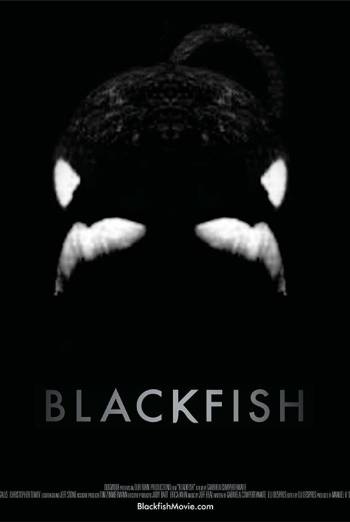
Blackfish is an almost-Oscar nominated documentary about keeping orcas (killer whales) in captivity. It focuses on Tilikum, a killer whale who was captured off the coast of Iceland in 1983, and now lives at SeaWorld in Florida. Tilikum has killed or been implicated in the deaths of three people, two of whom were his trainers at SeaWorld. The most recent incident received widespread media coverage and was the subject of an excellent article by Tim Zimmermann (a producer of this movie), entitled Killer in the Pool.
The documentary is primarily built around interviews with several former SeaWorld trainers, and uses news reports, home videos, interviews with other players, and other footage to fill in the details of how the orcas are captured, kept and trained. There is a disturbing interview with a man who was involved in the capture of baby killer whales for sale to marine parks – this is no longer done in the United States as a result of a backlash against the practice from the general public, but Russia has no reservations about continuing to do so.
The documentary has had an impact on SeaWorld’s profits and popularity – not as much as I’d like, but it’s noticeable. Several musicians have refused to perform at the parks, citing new awareness following Blackfish as the reason. The documentary exposes the factual errors that SeaWorld staff persist in repeating to the public – an example is their claim that the lifespan of captive orcas is as long or longer than orcas in the wild because they get such good veterinary care, and they aren’t exposed to the dangers of the open ocean. Captive orcas actually have significantly shorter lifespans (and more miserable lives) than their wild counterparts.
This is an upsetting film, but not only for the reasons I expected. While it is harrowing to watch a five ton animal dragging a human being underwater, I actually found it more upsetting to watch the five ton animal simply leaping and swimming around in its tank. I don’t think it’s suitable for children, but you should watch it.
For further reading on this subject I recommend Death at Seaworld, and this article at Southern Fried Science by Naomi Rose, who was heavily featured in the same book. CNN has shown the documentary several times, and there are some clips and a short article about it here. Producer Tim Zimmermann’s website has updates on various subjects related to SeaWorld, cetaceans in captivity, and (if that’s your thing) veganism.
For the other side of the argument, there is (for example) this advertorial-style article at CNN, in which the author claims that marine parks make valuable contributions to science, research and conservation, and offers the solution that because the orcas’ natural habitat is being polluted, they should be kept in tanks for their own safety. Someone should tell the author that it is possible to manage marine mammal strandings (in South Africa, for example) without the help of theme parks.
You can get a copy of the dvd here if you’re in South Africa, otherwise here or here.







